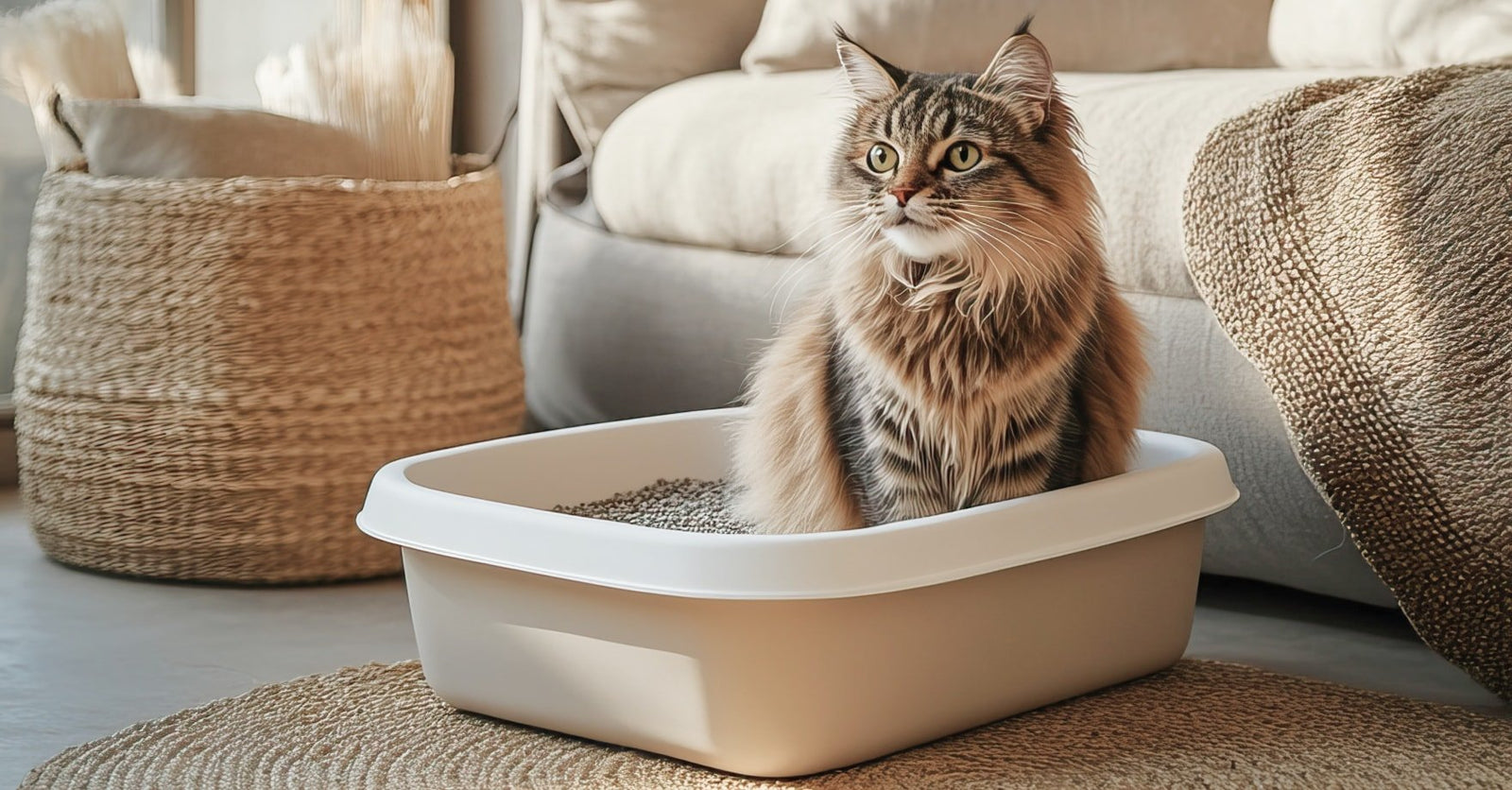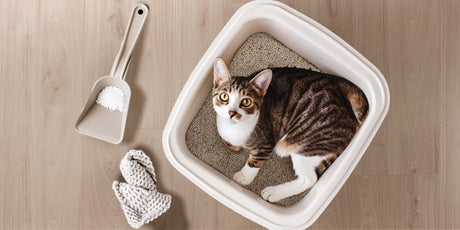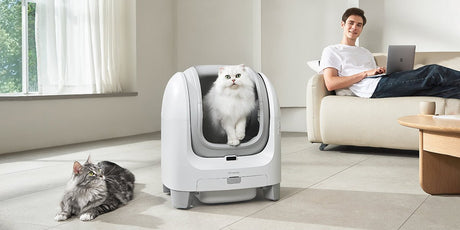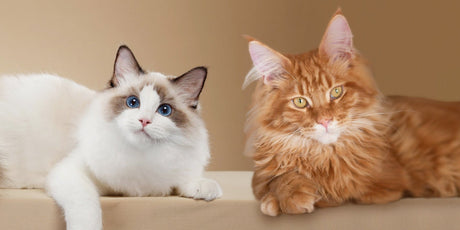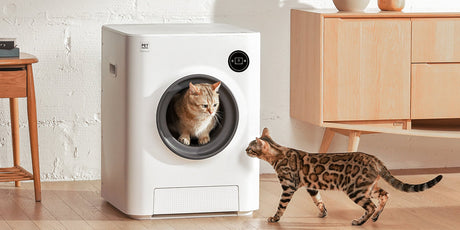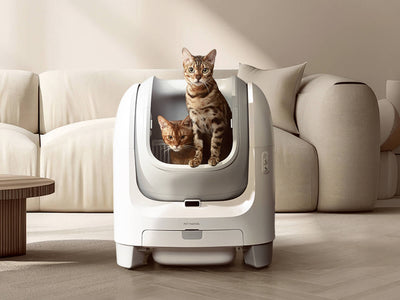With so many different types and prices of litter boxes, choosing one is already a difficult task. However, knowing where to keep cat litter box is even more challenging. I hope that by reading this article, you can solve all the problems related to the placement of the litter box. Therefore, we will thoroughly analyze this issue from the following aspects:
- Why does the litter box need to be in a suitable location?
- What are the principles for placing the litter box?
- Which room and position should I choose to place my litter box?
In the third section, we will discuss whether these locations are suitable for you and your cat by considering the cat's needs, your living conditions, and aesthetics.
Section 1: Why choose an appropriate location for the litter box?
For your cat, a litter box in a location it likes will make the cat feel secure and more willing to use it, thus avoiding excretion outside the litter box. When the litter tray is kept in a relatively quiet place, your cat will feel at ease while using it and won't avoid it due to being startled or disturbed. For humans, a well-ventilated location helps with odor control, and a convenient placement makes cleaning easier, keeping the home environment fresh. It's important for both you and your cat because the location you choose may affect the hygiene of the litter box, which could impact the health of your cat and even your own health.
Section 2: What are the principles for placing a litter box?
Try to meet most of the following conditions as much as possible, though not necessarily all, unless your conditions allow.
1. Unobstructed and easily accessible
Place the kitty box where the cat frequently appears, respecting the cat's preferences, and ensuring easy access without any physical barriers. If not, the cat might pooping outside litter box, causing hygiene issues in the home.
2. Keep distance from cat food, water, and sleeping areas
Cats instinctively like to separate their litter box from their eating and resting areas to avoid odor interference and maintain hygiene.
3. Minimal traffic and noise
Cats need a sense of security and privacy when using the litter box. If the environment is too noisy or frequently has people passing by, the cat might lack a sense of security and refuse to use the litter box.

4. Good ventilation
Proper air circulation helps dissipate odors, keeping indoor air fresh, reducing bacterial growth, and maintaining household health. A open top or entry cat toilet has better performance to help air flow than a encolosed one.
5. Moderate temperature and low humidity
The litter box should be placed in a warm but not hot, dry, and non-humid environment. A comfortable environment is more appealing to cats, while high temperature and humidity can affect litter clumping, accelerate bacterial growth, and spread odors, threatening household health.
6. More than one entry and exit route (especially in multi-cat households)
If possible, provide multiple approaches to and from the litter box, offering more choices to the cat. In multi-cat households, there may be competition and territorial awareness among cats, and multiple entry and exit routes can prevent one cat from blocking another from using the litter box.
7. Good lighting and room
Place the litter box in a well-lit area to ensure the cat can see clearly at night. Although cats have excellent night vision, if the room is completely dark at night, it is recommended to install a small night light, which is sufficient without using particularly bright lighting.
8. Visibility of the surrounding environment
Choose a place where the cat can observe the surroundings while using the litter box, allowing it to quickly retreat if it feels threatened. By the way, choosing an open litter box is also necessary.
9. Easy to clean
Choose a location that makes it easy for you to clean waste, with a cleanable surface and a litter control mat to manage litter scatter. Do not let these factors become obstacles to cleaning the litter box, as you need to maintain a tidy home environment.
10. Relatively fixed location
Cats are habitual animals, and once a suitable location is chosen, do not change it frequently. This could confuse the cat or cause stress, affecting its toileting. If you must move the litter box, ensure you do so gradually, moving it a few inches a day until the box reaches the new location.
Section 3 Which room and location are suitable for placing the litter box?
Below are the most mentioned places on Google, ranked from most to least popular. However, not every place is suitable for you, as different house layouts have different configurations. Someone may ask whrere to put a litter box in a small apartment, while others may be in trouble with a good place for two cats. I suggest using the principles from the “Section 2” to evaluate your specific room and location before your sifting.
1. Bathroom
The bathroom is one of the most frequently mentioned places, with many advantages such as no need for additional odor control, easy-to-clean floors, and good ventilation. If your litter can dissolve in water, clumped litter can be directly disposed of via the toilet. But if you only have one bathroom, or it's small, or poorly ventilated, or hot and humid, and doesn't have dry-wet separation, the bathroom may not be a suitable place for you.
2. Bedroom
Bedrooms are generally spacious with good ventilation and a quiet environment, meeting conditions that cats like. Corners of the bedroom or open areas in the closet are good options for placing the litter box. However, if your cat's schedule does not match yours or it wakes up earlier than you do, it might disturb your sleep. Additionally, if you are sensitive to odors or have respiratory issues, litter dust and odors could affect your health.

3. Living Room
Almost as frequently mentioned as the bedroom, the living room offers spacious areas, ample light, and good ventilation, similar to the benefits of the bedroom. If there are sofas, bookshelves, or curtains for covering, it won't confuse guests. But if your living room often hosts visitors or has frequent family activities, it may be noisy for the cat, and odors might be noticeable to you.
4. Laundry Room
This is a room people usually don't enter frequently and is relatively easy to clean. Its only issue is noise; washing machines and dryers can be unpredictably noisy and might scare your cat unless your cat is used to and accepts them.
5. Storage Closet
It offers dual privacy. For cats, a hidden corner or space gives them a sense of security; for home layouts, if hidden well, guests might not even notice you have a cat. You can find various creative “cat litter box furniture” by searching online: vase, living room cabinet, wicker box with lid, dressing room, dressing table be covered, even under the sink... However, due to their hidden nature, these areas often overlook ventilation.

6. Corridor
An open option is also viable, choosing places without frequent traffic. It could be in the middle of the hallway or at its ends. For cats, corridors are easily accessible and suitable for a quick "escape." But if your corridor is busy, it's not an appropriate location.
7. Basement and Garage
Basements typically have some ventilation, are quiet, with few disturbances, and are far from the main living areas, reducing odor issues. However, check if your basement is poorly ventilated, damp, moldy(or unfinished room), and if your cat is older, access might not be easy.
8. Kitchen and Dining Room
Like the bathroom and laundry room, they are easy to clean and often well-ventilated. Using the aforementioned hiding methods, such as covering the litter box under the dining table with a large tablecloth or converting the space under the sink into a litter box area, are good options. However, the prominent issues are odor and hygiene, which might affect your dining experience.
9. Under the Bed
If there's enough height and ventilation under your bed, it's also a good choice, as nearly 100% of cats like this hidden and quiet area. The common concerns are the inconvenience of cleaning and odor issues.
Conclusion
I hope this article is useful and can help you decide or improve the placement of your litter box. When choosing the specific room and location, please refer to the "placement principles" in the second section and adjust according to the cat's personality, household members' habits, and room usage to ensure the cat's health and household comfort.

